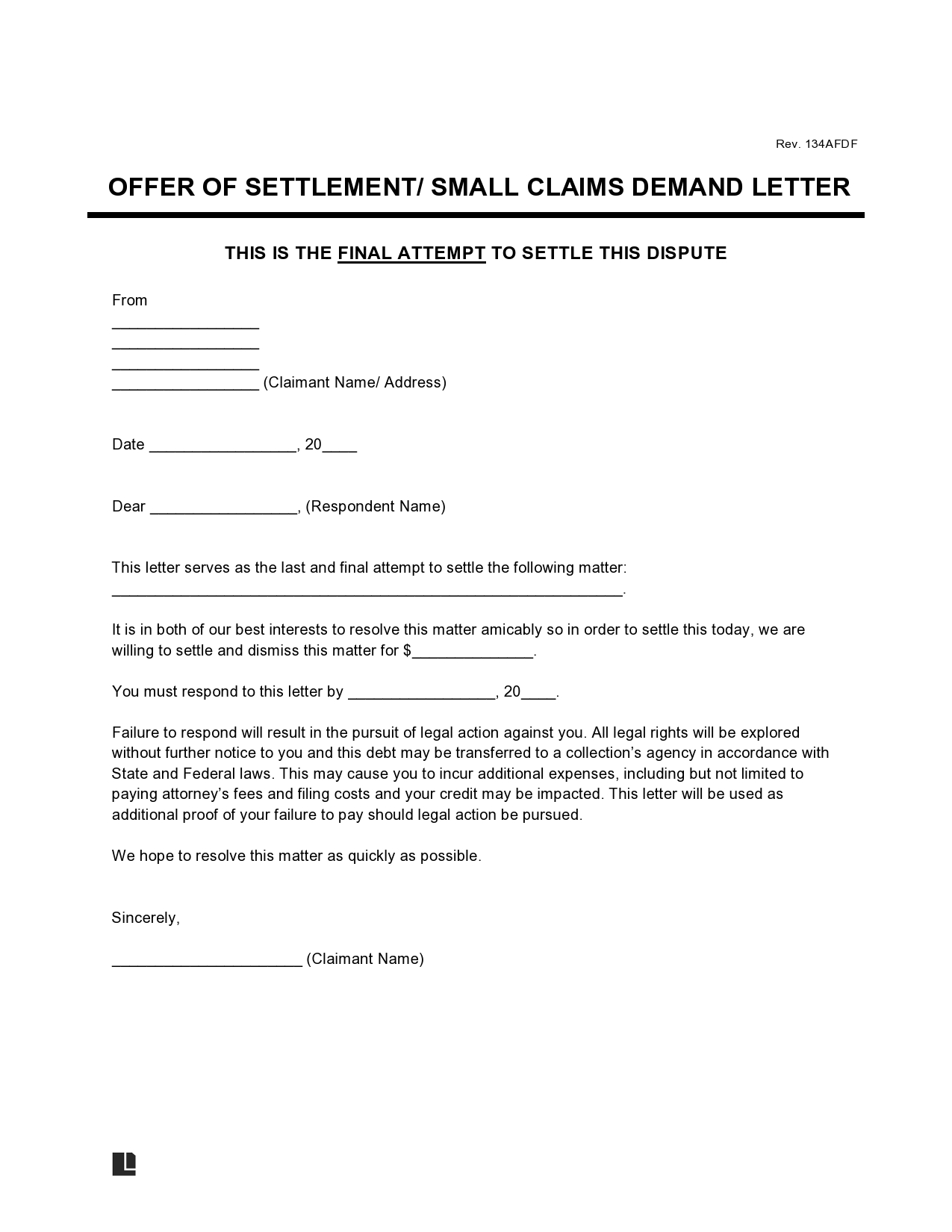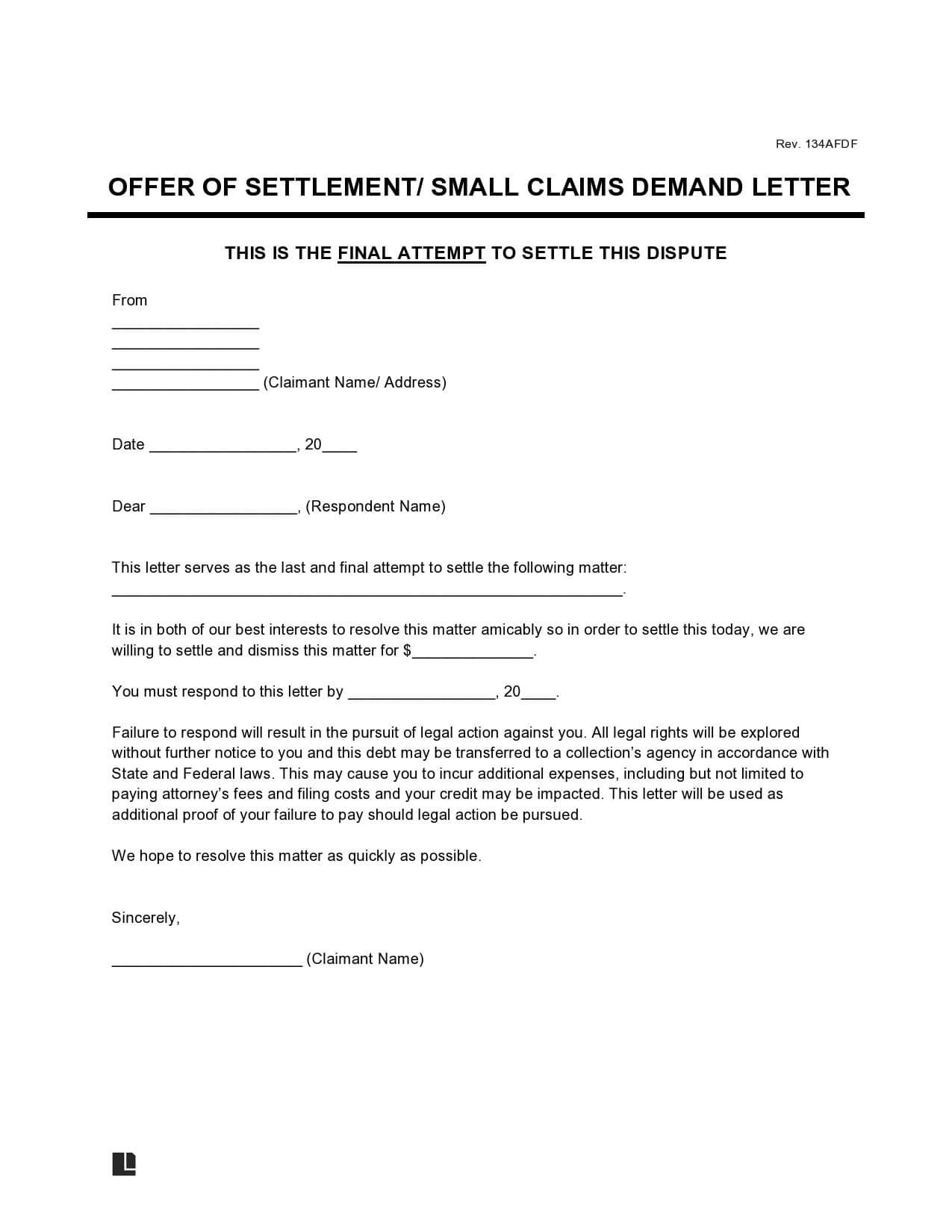A small claims demand letter is a formal written document sent by one party to another requesting payment or action owed to them, usually after initial communication has failed to resolve the issue. It is generally used before initiating a small claims court case.
By sending a small claims demand letter, you may be able to resolve the issue peacefully without taking any further action. Still, it can serve as substantial evidence if you need to litigate the issue.
If you want to formally request a refund for an unsatisfactory product or service, use our refund demand letter.
What Is Small Claims Court?
Small claims court, sometimes called “people’s court” or “conciliation court,” is a type of civil court proceeding that handles disputes involving small amounts of money. The maximum amount to be held in small claims court varies by state.
A small claims demand letter is often enough to settle the dispute, but you should be prepared to go to court if that is not the case.
Generally, small claims cases can be handled quickly. After seeing the evidence and hearing the case, a judge will order the defendant to pay the money owed to the plaintiff or will dismiss the case.
They may also grant a countersuit from the defendant, requiring the plaintiff to pay.
Why File a Small Claims Case?
Even if someone only owes you hundreds or a few thousand dollars, that money can make a big difference for average people. If you agree they will pay you a certain amount, you are still entitled to that money.
Small claims court allows you to be heard and to receive the money you’re owed.
Small Claims Court Limits for Each State
Each state will have different limits regarding how much money can be sued for in small claims court. This limit is often in the thousands, so small claims are often for hundreds or thousands of dollars. The state limits for small claims court are as follows:
| State | Dollar Amount |
|---|---|
| Alabama | $6,000 |
| Alaska | $10,000 |
| Arizona | $3,500 |
| Arkansas | $5,000 |
| California | $10,000 for individuals; a plaintiff may not claim over $2,500 twice in the same year. $5,000 for a business or public entity. $6,500 for a guarantor that charges for guarantor services. COVID-related rental debt claims of any amount until February 1, 2025. |
| Colorado | $7,500 |
| Connecticut | $5,000 except in cases of landlord-tenant security deposits |
| Delaware | $25,000 |
| District of Columbia | $10,000 |
| Florida | $8,000 |
Small Claims Demand Letter Example
Need to send a small claims demand letter? This example will give you the information you need to include.
Nicolo Byrnes Dear Jean Weston, This letter serves as a first formal demand for a payment of $600, the amount loaned to you on January 17, 2023, for your round-trip plane tickets for a trip to Destin, Florida. On that date, I agreed to lend you $600 so that you could join the rest of a mutual friend’s bridal party in Destin on the condition that you pay me back by the end of the year. To this date, August 25, 2023, you have still not paid me back any of that amount. I have attached a copy of our text exchange in which you promised to pay me back in full by the end of the year and the receipt of the Zelle transaction. I have made previous attempts to contact you about this matter by text on August 7, 2023, and in a voicemail left on August 20, 2023. As of this date, I have received no response. If I do not receive a total payment of $600 by September 25, 2023, I will take further action by filing a claim in Michigan Small Claims Court. Sincerely, Nicolo Byrnes
9221 North Sycamore Court
Grand Haven, MI 49417
August 25, 2023
Jean Weston
8884 King Street
Grand Haven, MI 49417
How to File a Small Claims Case
A small claims case is relatively easier to prepare than issues worth more money. You must bring evidence of the original agreement and proof of the amount you are owed. Here are five steps to filing a small claims case:
Step 1: Write a Small Claims Demand Letter
The first step is to write a small claims demand letter. Often, this is the only step that you will have to take. The threat of court can be enough to convince some people to pay even if they are dragging their feet. Please include evidence of your claim in the letter so the other person cannot easily dispute it.
If they pay within the time in your small claims demand letter, there’s no need to take further action. The dispute between you has been settled, and you can confidently move on. If, however, they refuse to respond to the small claims demand letter or refuse to pay, then you need to move forward with the case.
Step 2: File Your Case
The next step is to file a complaint and a small claims summons. You can find forms for complaints and summons at your local small claims court.
Your complaint should include exhibits that show evidence of the agreement and the money owed. For instance, screenshots of a text conversation or email, or even a slip of paper laying out the terms of the agreement, can go a long way for your case.
Step 3: Serve Your Small Claims Complaint
Send out a summons by certified, registered mail. This will need to be signed in person by the defendant. It will lay out when and why they will appear in court for the case.
If they fail to appear in court, the court will most likely side with you and require them to pay you the amount in question.
Step 4: Attend the Hearing
The court will set a date for your hearing. At that time, you must appear in court to present your case. In most situations, small claims court is just the plaintiff and defendant. Many states will not allow you to have an attorney represent you in small claims court, though an attorney may advise you before the case.
If you do not attend the hearing, the court will likely dismiss your case or side with the defendant. The burden is on you to prove your case; you cannot do that if you aren’t present.
Step 5: Wait for the Judge to Issue the Final Judgment
Small claims cases take less time on the whole than other civil cases. Most small claims cases are resolved within under a half hour. After this time, the judge will give their final judgment.
They may side with the plaintiff and demand the defendant pay all or some of the amount in the suit. They may dismiss the claim outright. On the other hand, they may grant part of the plaintiff’s claim and part of the defendant’s countersuit, ruling that each party has an amount to pay.
If you are unsatisfied with the case’s outcome, you may file an appeal with the court of appeals. Otherwise, the judgment is final.
How to Write
Every small claims demand letter will differ, but certain elements will always be necessary.
Your small claims demand letter must include:
- The amount you claim to be owed.
- A description of the events that led to that amount being owed.
- When the amount was initially owed to you.
- How much time has passed?
- How much time does the recipient have to pay you?
- The next steps you will take if they do not pay you.
In addition, it can help to lay out how you have attempted to reach them about the issue in the past. After receiving the small claims demand letter, the other party will pay if all goes well.
If they do not, however, that letter becomes evidence for your case. It will strengthen your chance to show that you made multiple attempts to resolve the issue before going to court, mainly if the defendant ignored those attempts.
The more written communication, the better for your case. That’s why, even though you and the other party know why they owe you the money, it is essential to ensure that the case details are described in the small claims demand letter.
You must also be sure that the other party receives the small claims demand letter. It’s best practice to send it by certified mail so that you will receive a receipt with their signature confirming that they received the letter.
Small Claims Demand Letter Sample
You can download our free small claims demand letter template below in PDF or Word format.

Frequently Asked Questions
How much does it cost to sue someone in small claims?
Before filing your case in small claims, be advised that there are filing fees for these cases. In some states, the filing fee may vary based on the amount of your claim. This fee will typically be under $100, but checking with your state government’s small claims proceedings before you move forward is best.
What is a small claims court hearing like?
In a small claims hearing, you and the defendant will appear before a judge. You may bring a witness with you if they can attest to some of the information in your claim beyond a “he said, she said” statement. The defendant may also bring a witness.
The case generally lasts between 10 and 25 minutes. The judge may make a final ruling as soon as both issues have been presented, or they may call a recess to review the facts before ruling.
Once the judge has ruled, the plaintiff and defendant must abide by the ruling or file an appeal with the Court of Appeals.
How do I prepare for the small claims hearing?
The most important thing is gathering all vital documentation. Although verbal contracts are legal, they can be challenging to prove. A written agreement is best, even if that “contract” is simply a text or email in which someone agreed to pay you a certain amount. This should be brought to your case.
If your case involves any damaged property, take pictures of the property damage. Images of what the property looked like before will also strengthen the case.
You should also bring a copy of your small claims demand letter and other records documenting your attempts to reach the defendant for payment. You may also choose to get a witness.
In most states, you cannot bring an attorney to represent you. It’s typically not advised, even in states where an attorney in small claims court can legally represent you. This is a small, simple matter that can usually be resolved between the plaintiff, the defendant, and the judge.
Hiring an attorney brings about extra, unnecessary fees. However, you may hire an attorney to advise you and help you build the case before going to court.
